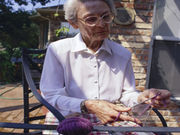Correlation is attenuated after accounting for cardiometabolic diseases
FRIDAY, Dec. 30, 2016 (HealthDay News) — For older women, low vitamin D is associated with incident frailty, according to a study published online Dec. 23 in the Journal of the American Geriatrics Society.
Brian Buta, M.H.S., from Johns Hopkins University in Baltimore, and colleagues conducted a prospective longitudinal cohort study involving 369 women from the Women’s Health and Aging Study II, aged 70 to 79 years, who were free from frailty at baseline. The authors examined the correlation between serum circulating 25-hydroxyvitamin D (25[OH]D) concentration and incidence of frailty.
The researchers found that the incidence rate of frailty was 32.2 and 12.9 per 1,000 person-years in participants with 25(OH)D <10 ng/mL and ≥30 ng/mL, respectively. Higher incidence of frailty was exhibited by those with lower 25(OH)D in cumulative incidence analyses, although the differences were not significant (P = 0.057). The incidence of frailty was nearly three-fold higher with 25(OH)D <10 ng/mL versus ≥30 ng/mL after adjustment for demographics, smoking, and season (hazard ratio, 2.77; 95 percent confidence interval, 1.14 to 6.71). The relationship of 25(OH)D <10 ng/mL with frailty persisted after adjustment for body mass index, but was attenuated after accounting for cardiometabolic diseases (hazard ratio, 2.29; 95 percent confidence interval, 0.92 to 5.69).
“Low serum vitamin D concentration is associated with incident frailty in older women; interestingly, the relationship is no longer significant after accounting for the presence of cardiometabolic diseases,” the authors write.
Full Text (subscription or payment may be required)
Copyright © 2016 HealthDay. All rights reserved.








